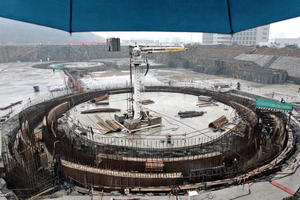Nuclear mattersChina's nuclear power expansion is based on thorium
The thorium fuel cycles produce almost no plutonium, and fewer higher-isotope residuals; thorium is much more abundant than uranium, and the reduced plutonium output eases proliferation concerns; the energy output per ton is also attractive; China has committed itself to establishing an entirely new nuclear energy program using thorium as a fuel; six heavy-water thorium reactors are planned in India, which has the world’s largest thorium deposits

China's Fangjiashen nuclear power plant during construction // Source: energytribune.com
China has committed itself to establishing an entirely new nuclear energy program using thorium as a fuel, within twenty years. The LFTR (Liquid Fluoride Thorium Reactor) is a 4G reactor that uses liquid salt as both fuel and coolant. China uses the more general term TMSR (Thorium Molten-Salt Reactor).
The thorium fuel cycles produce almost no plutonium, and fewer higher-isotope residuals, the long-lived minor actinides. Thorium is much more abundant than uranium, and the reduced plutonium output eases proliferation concerns. The energy output per ton is also attractive, even though thorium is not itself a fissile material.
Thorium reactors are also safer, with the fuel contained in a low-pressure reactor vessel, which means smaller (sub-500GW) reactors may be worth building. The first Molten-Salt Breeder prototype was built at Oak Ridge in 1950, with an operational reactor running from 1965 to 1969. Six heavy-water thorium reactors are planned in India, which has the world’s largest thorium deposits.
The Register reports that the design has also had its champions in Europe, but planning restrictions and a continent-wide policy preoccupation with conservation and renewables have seen little commercial action. This might change.
A private company founded by Kazuo Furukawa, designer of the Fuju reactor, called International Thorium Energy & Molten-Salt Technology Inc. (iThEMS) aims to produce a small (10KW) reactor within five years. Furukawa is aiming for a retail price of $0.11 per kWh.
Just to put that into perspective, the U.K.’s feed-in tariff ranges from 34.5p/kWh for a small wind turbine to 41.3p/kWh for a retro-fitted solar installation, making LFTR attractive.
View this YouTube video for a good 15-minute introduction to LFTR.
